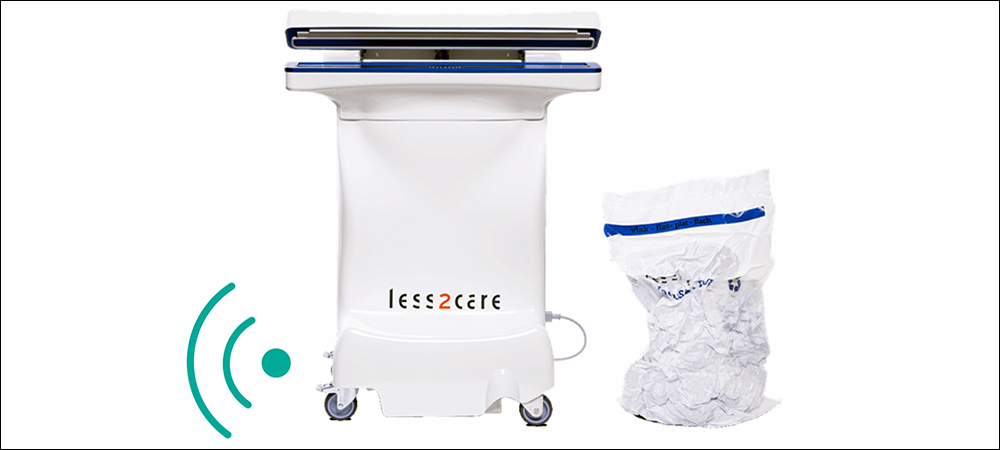Jun 03, 2021Medical waste collection is a necessary part of patient care at hospitals and care facilities, but when performed improperly it can release odors and pose potential infection risks, as well as create environmental hazards in the waste stream. Therefore, Near Field Communication (NFC) technology is being used to ensure the proper use of products that contain vacuum-sealed waste, thanks to Dutch company Less2Care. The company's VacuSan system was designed to provide vacuum sealing and safe disposal of materials from healthcare environments.
By incorporating NFC RFID technology, the system can automatically detect whether the correct Less2Care-branded bag is being used, and thereby better ensure sustainable and odorless disposal of medical waste. The RFID reader built into the device, as well as the RFID tags on waste bags and the firmware to manage the collected data, is provided by Aucxis RFID Solutions. The Less2Care solution is already in use at several Dutch, German and Scandinavian nursing homes, while the NFC RFID version of the system is slated to launch later this year.

Less2Care's VacuScan system
Jop van Haaren, Less2Care's CEO, founded the company in 2010 to sell vacuum packaging machines. After researching how medical waste was being managed by hospitals and other healthcare facilities, he discovered that vacuum sealing waste could eliminate odors and ensure that there was no leakage or contamination due to improper waste-handling. The company thus built a solution to enable the efficient collection, vacuuming and disposal of such materials. "We optimized this fact," he recalls, "by setting up a complete process from the resident's bed to the back of the rubbish truck."
Hospitals and care facilities pay a fixed cost per quarter for the service, while Less2Care's maintenance staff comes onsite to set up the solution and help healthcare personnel learn how to operate it. Less2Care's specialized bags are filled at a patient's bedside and are placed in a wheeled device known as a VacuSafe, on which they can be rolled from room to room or from bedside to bedside. The filled bags are attached to a vacuuming machine known as a VacuSan, which sucks out the air, while filters capture the bacteria that create odors.

Jop van Haaren
Using the wrong type of bag with the system, however, can create problems, van Haaren says. The dedicated bags are partly made from recycled materials, he explains, adding that his company is the only supplier of vacuum bags with a "gas barrier" made from one raw material. All others on the market, he notes, consist of multiple plastics, making the recycling process more difficult. The bags are 110 microns (0.004 inch) thick and are designed specifically to be vacuumed and disposed of with limited impact.
"It is important that waste collection by the healthcare sector also happens in air- and gas-tight bags," van Haaren states. The bags are capable of replacing the waste-water separator or grinder processes used for the disposal of some medical waste, he says, and dedication residues and cleaning agents now end up in the sewers less often. To ensure the system will not operate without the proper bag, Less2Care began working with Aucxis, which provides NFC 13.56 MHz tags compliant with the ISO 14443 standard.
The tags can either be attached to the bags or be embedded in the bag material, though Less2Care currently opts to attach the tags. When workers collect waste in a bag and intend to have it vacuumed, the bag needs to be authenticated via the NFC system. Once the bag is properly positioned in the VacuSan, the reader built into the machine captures the unique ID number encoded on the tag and thereby confirms that the appropriate bag is being used. The capture of that tag ID prompts the vacuuming process to begin. If no tag is interrogated, the VacuSan will not operate.

Patrick Catthoor
The NFC-enabled version of the solution is expected to be made available later this summer, after which Aucxis will supply Less2Care with approximately 100 to 1,000 NFC readers annually, according to Patrick Catthoor, Aucxis's senior account manager and business consultant. Aucxis first provided a proof of concept for Less2Care last year, then started to develop the fitted NFC reader to integrate into the VacuSan this past January. For Aucxis, Catthoor says, the challenge was to develop an optimally performing NFC reader that could be integrated into the VacuSan device, at a location where it could read tags at close range.
Aucxis used its internal R&D department to develop the hardware according to these specifications. "Furthermore," Catthoor states, "we inject our own developed firmware on the NFC readers so it is optimally attuned to the final application and efficiently communicates with the VacuSan internal logic." The result was a single-board NFC reader built on a microcontroller that comes with an integrated antenna. The reader employs power from the VacuSan device and communicates with its programmable logic controller, which controls the VacuSan's operation. The close read range enables the system to prompt the vacuuming process only when the bag is locked into position.
To date, the NFC component has been used only to authenticate each bag prior to vacuuming. In the future, however, the tags could be leveraged to identify waste further in the disposal process. "Today, we have 700 VacuSans in the Netherlands and about 1,000 all over Europe," van Haaren reports. He sees the product's deployment growing across the continent—last year alone, he adds, the company's business grew by 80 percent.

